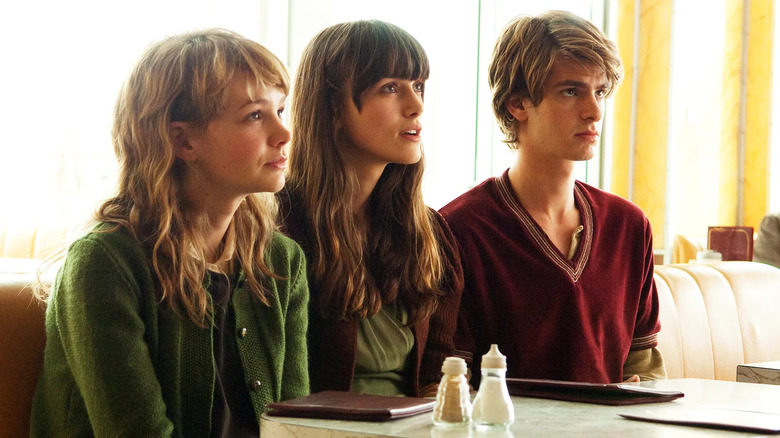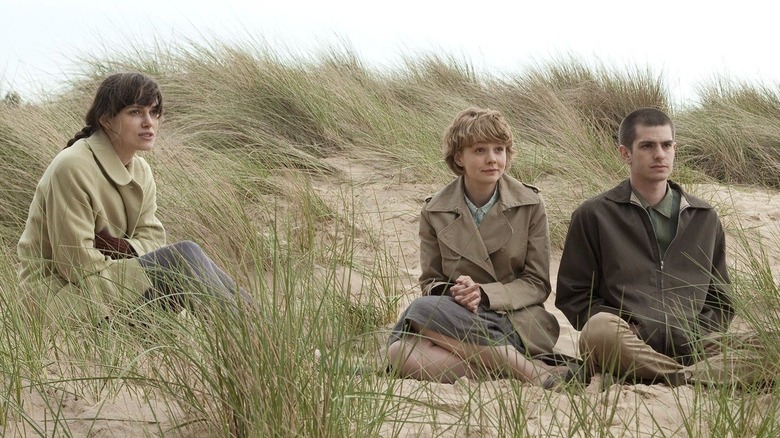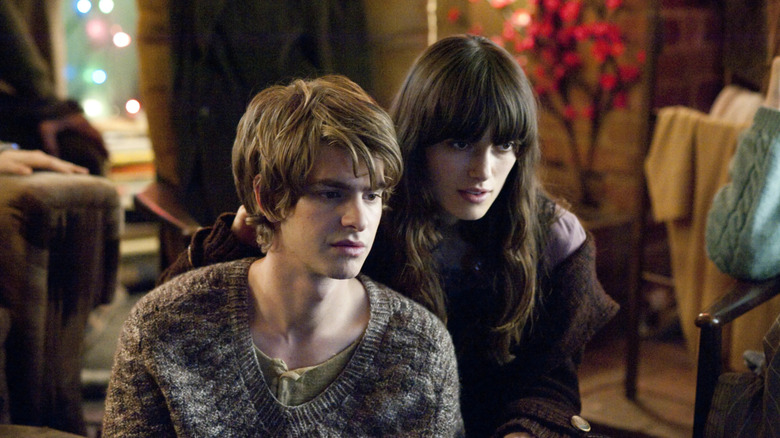Alex Garland's Most Underrated Sci-Fi Movie Was Based On A Beloved Novel
There is a strange mythos in popular culture surrounding the notion of dying young. James Dean was a fan of the phrase "Live fast, die young, and have a good-looking corpse," and it proved prophetic when he died in a car wreck at the age of only 24. In the world of music, Mott the Hoople opened "All the Young Dudes" with references to suicide ("Don't want to stay alive when you're 25") and the infamous "27 Club" – an unofficial collection of famous people who died at age 27 — features illustrious rock 'n' roll stars like Jimi Hendrix, Amy Winehouse, Janis Joplin, and Kurt Cobain. It's a weird mix of tragedy and romanticism, but in reality, it sucks to die at any age — especially when you're in the prime of life. Nobel Prize-winning author Kazuo Ishiguro tackled that subject from a very different angle in his heartbreaking novel "Never Let Me Go," which became an underrated sci-fi movie written by Alex Garland.
Ishiguro's book was first published in 2005, less than 10 years after Dolly the Sheep made headlines by becoming the first successfully cloned mammal. She was the only one of 277 attempts that made it to birth and she only lived to six years old, which was half the life expectancy of her particular breed. The breakthrough took cloning from science fiction to reality and raised many ethical concerns, particularly around the question of whether scientists could (or should) ever replicate humans.
Ishiguro name-checks Dolly when talking about the inception of "Never Let Me Go," in which he took a somber, lo-fi approach to a dystopian tale about cloning humans for organ harvesting. That's not much of a spoiler because Mark Romanek's elegant 2010 adaptation (working from a screenplay by Garland) gives away the mystery very early on. Instead, Garland's script focuses more on how the story's three young protagonists have come to terms with their pre-ordained fate and try to make the most of their allotted time. It's one of Garland's more personal works, perhaps stemming from his friendship with the author. The pair would discuss the themes over lunch during Ishiguro's writing process and Garland read the novel at a very early stage, putting a film version into motion before it was even published. Since then, "Never Let Me Go" has been overshadowed by Garland's more high-profile movies like "Ex Machina" and "Annihilation," both of which he also directed. Let's take a look back at this subtle and thought-provoking film.
What happens in Never Let Me Go?
Unlike Kazuo Ishiguro's novel, Romanek's "Never Get Me Go" spells things out from the start: We are in an alternate reality where a medical breakthrough has enabled people's life expectancy to exceed 100 years. We meet Kathy H. (Carey Mulligan), a caregiver gazing sadly in at one of her donors about to undergo an operation. Her memories take us back to 1978 and Hailsham, a boarding school overseen by the stern Miss Emily (Charlotte Rampling). It all seems wholesome enough and the kids are taught to take care of their bodies, one of several hints that something is off. Of the children, we focus on Kathy (played by Isobel Meikle-Small in her younger years) and her friends Ruth (Ella Purnell, growing up into Keira Knightley) and Tommy (Charlie Rowe/Andrew Garfield). The latter is a simple lad prone to fits of rage who has a natural affection for Kathy, but a jealous Ruth inserts herself between them and becomes Tommy's girlfriend.
The kids discover the truth of their situation when Miss Lucy (Sally Hawkins) tells them they have been raised as organ donors and their purpose is to die young in order to save the lives of others. Except in this process of cloning humans for organ harvesting, they don't use the word "die." Clones "complete," usually after three or four donations. Upsettingly, their reaction is one of mild disappointment.
The rest of the film follows Kathy, Ruth, and Tommy as young adults as they are allowed out in the world to enjoy life for a few years before they start their donations. Ruth and Tommy are still together and Kathy applies to become a carer, which will postpone her own donations while she offers solace to donors. Years later, her path crosses with her old friends again, who have both started the process. Time is short, but there are rumors of a deferral program for couples who can prove they are truly in love...
"Never Let Me Go" leaves most of the sci-fi elements in the background, an appropriate choice because Ishiguro only ever intended cloning as a plot device for his story of three students whose life was destined to end prematurely. By the author's own admission, the novel tries to have it both ways, offering a cautionary tale and a life-affirming metaphor for making the most of the time we have allotted. The movie has the same strengths and weaknesses.
Never Let Me Go is a quietly powerful film
"Never Let Me Go" is a beautifully shot movie that deliberately evokes nostalgia for a very specific kind of Englishness. It's a retro world of boarding schools, rustic cottages, and slightly dog-eared seaside towns, and everything is just a little off; the 1970s segment looks more like a '50s period drama, and the '90s chapter looks more '80s. It's a clever choice, taking us to that half-imagined England of the past where everyone kept a stiff upper lip and no one liked to grumble. It's like a dystopian extension of the themes explored in Kazuo Ishiguro's earlier novel, "The Remains of the Day" (and the underrated movie version starring Anthony Hopkins), in which the characters are imprisoned within a buttoned-up social structure where they are unable to fully express their emotions.
Something similar is going on in "Never Let Me Go." My first reaction was: "Why don't they try to escape?" But that's not how people do things in Ishiguro's world, and it's all the more chilling for it. Escape has never even crossed their minds. Kathy, Ruth, and Tommy accept their fate passively because they are indoctrinated by a system where they have grown up getting told that being a donor is the sole reason for their existence. Besides, they've had it pretty good — we get hints that Hailsham is the exception and other schools are little more than battery farms, drawing a comparison to the mistreatment of animals bred for food. All our young protagonists can do is make the best of things and try not to complain.
The quaint style makes the horror of the situation seem all the more insidious and pervasive. It certainly wouldn't have the same effect if it was all holograms and flying cars. In this alternate world, everyone has come to accept harvesting clones for spare parts as part of everyday life, including the clones themselves. It's a bleak situation and the film stayed with me for a long time, although my main gripe is that our central trio aren't given enough joy and passion to successfully balance out the cautionary tale with the supposedly positive "life is what you make it" angle. "Never Let Me Go" is a quietly powerful film that offers plenty of food for thought — I just wish it did a little more to stir the heart and soul.


